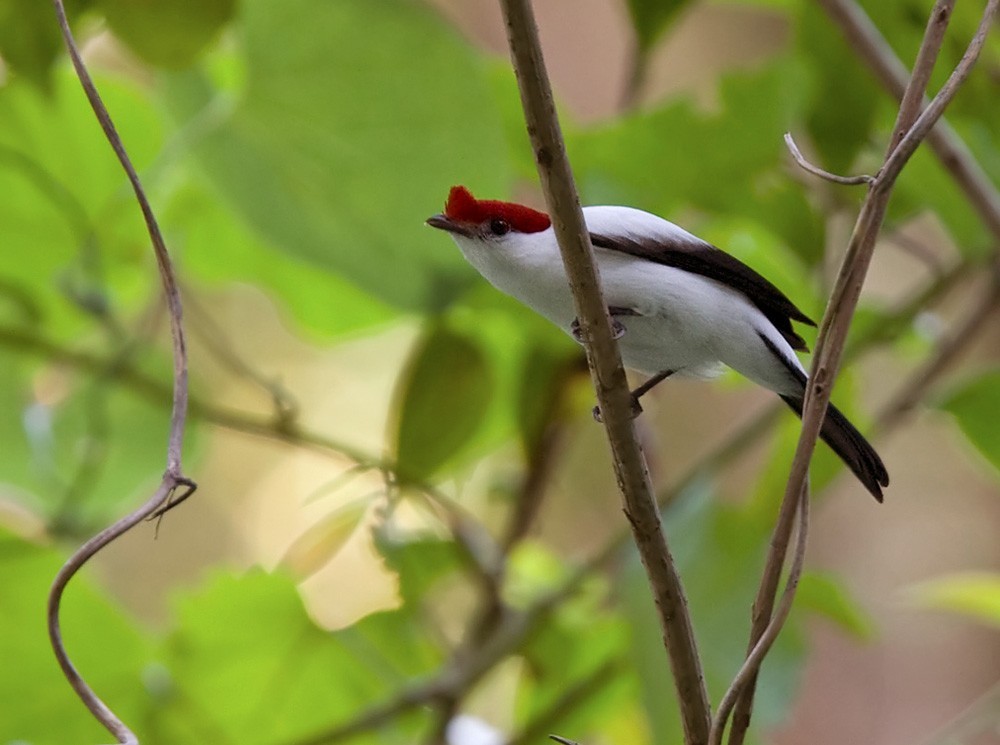Araripe Manakin
A species of Helmeted Manakins Scientific name : Antilophia bokermanni Genus : Helmeted Manakins
Araripe Manakin, A species of Helmeted Manakins
Botanical name: Antilophia bokermanni
Genus: Helmeted Manakins
Content
Description General Info
 Photo By Lars Petersson
Photo By Lars Petersson Description
As typical of most manakins, males and females have a strong sexual dimorphism in the colours of the plumage. As in the helmeted manakin, it is a relatively large and long-tailed manakin, with a total length of c. 14.5 centimetres (5.7 in). The strikingly patterned males have predominantly white plumage. With the exception of the white little wings coverts, the wings are black as the tail. From the frontal tuft, over the crown, down to the middle back runs a carmine red patch. The iris is red. The females are mainly olive green and have pale green upperparts. They have a reduced olive green frontal tuft. 
Size
16 cm
Nest Placement
Tree
Feeding Habits
Araripe Manakin primarily feed on the fruit of Clidemia biserrata, comprising 80% of their diet, alongside arthropods. Females exhibit a varied diet due to greater camouflage and a longer bill for handling diverse fruits, while males consume a less diverse range due to predation risk.
Habitat
The araripe Manakin is typically found in evergreen secondary forests, frequently transitioning into nearby open areas. This species favors forested environments, thriving in regions that contain a mixture of dense tree coverage and some degree of adjacent open space, suitable for its survival and reproduction.
Dite type
Frugivorous
General Info
Feeding Habits
Bird food type

Fruit
Distribution Area
This species is endemic to the Chapada do Araripe (Araripe uplands) in the Brazilian state of Ceará in the north eastern region of the country. It is only fifty kilometres long and one kilometre wide and the typical habitat apparently is a consequence of the soils formed from the Early Cretaceous Santana Formation limestone. The pure breeding range has a size of only 1 km² and lies in a theme park. It is likely to be more widespread than presently known, although surveys in nearby Balneario das Caldas failed to locate any individuals. 
Species Status
In 2000 there was an estimated population of less than 50 individuals and it was considered as one of the rarest birds in Brazil and in the world. Only three males and one female were found until that date. In 2003 the estimations were more optimistic and BirdLife International assumed the population of 49 to 250 individuals. In 2004 it proceeded on the assumption that less than 250 individuals exist in the wild which was based on 43 discovered males. In 2000 a theme park with swimming pools and asphalted roads was built at the type locality Nascente do Farias and the largest part of its original habitat became destroyed. The cleared trees were replaced by banana plantations. The last assessed population was on August 7th, 2018. An estimated 150 - 700 mature individuals are living in Brazil. At the BirdLife International celebrity lecture held in Peterborough on 16 August 2008, it was announced that Sir David Attenborough would be championing the Araripe manakin in an effort to raise funds to help protect this rare bird. There are approximately 500 pairs of the Araripe manakin left. Sir David was presented with a picture of the manakin following his lecture, which was on Alfred Russel Wallace and Birds of Paradise. 

 Photo By Lars Petersson
Photo By Lars Petersson Scientific Classification
Phylum
Chordates Class
Birds Order
Perching birds Family
Manakins Genus
Helmeted Manakins Species
Araripe Manakin